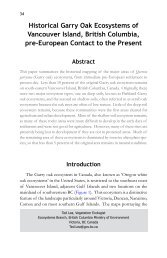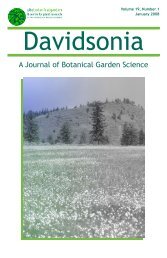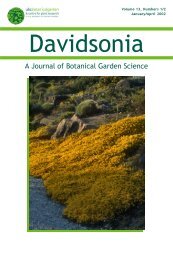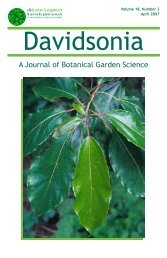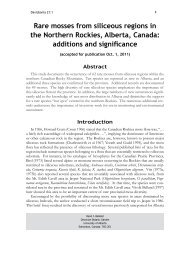pdf wkg Dav.14-14 - Davidsonia
pdf wkg Dav.14-14 - Davidsonia
pdf wkg Dav.14-14 - Davidsonia
Create successful ePaper yourself
Turn your PDF publications into a flip-book with our unique Google optimized e-Paper software.
<strong>Davidsonia</strong> <strong>14</strong>:4<br />
153<br />
arguta with much smaller, smooth-skinned fruit that usually ripens in October.<br />
You need to look right up into the canopy to spot the fruit. Before you<br />
leave, take a few minutes to look at all the winter vegetables that you can<br />
grow and harvest.<br />
In both the Winter Garden and the E.H. Lohbrunner Alpine Garden, you<br />
will find my favourite berries, Gaultheria mucronata (syn. Pernettya mucronata),<br />
an evergreen shrub from Chile. The plump berries are white, red, pink or<br />
mauve and will remain on the plants until late spring.<br />
The Sorbus hupehensis ‘Pink Pagoda’ in the bottom corner of the Winter<br />
Garden as you walk along the path below the Alpine Garden is the easy to<br />
see. The fruit, a small pome, starts pink and fades to white as the winter<br />
progresses. Then one day in spring the migrating robins find the tree and<br />
very soon the fruit is gone. Malus ‘Adirondack’ grows near the ‘Pink Pagoda’<br />
and its wonderful red-orange fruit remain for most of the winter. Cotoneaster<br />
and many Ilex (holly) species, including the deciduous hollies Ilex verticillata<br />
and Ilex ‘J.C. van Toll’ provide further interest and it is hard to miss Arbutus<br />
unedo (strawberry tree) with its vivid red-orange fruit. You can get a closer<br />
look at this plant in the planting outside the Shop In The Garden. If you<br />
walk along the grass towards the stream you will see a delightful small tree<br />
with bright red fruit, Crataegus grignonensis. If you are lucky enough to see it<br />
capped with snow, you will have the perfect picture.<br />
As you approach the Garden exit, on the left side of the main path, you<br />
will see the red berries of the female Skimmia japonica. On the ground to the<br />
left, opposite the purple flowering, Aconite are bright red, cone-shaped seed<br />
heads of Arisaema consanguineum.<br />
There is an enormous variety of shrubs and trees in fruit, including<br />
Mahonia, Chaenomeles, Sarcococca and Stranvaesia, to name a few. But don’t leave<br />
without one last stop to see the many beautiful small pomes on Sorbus ‘Eastern<br />
Promise’ growing on the boulevard outside the main gate. It is hard to<br />
describe the exact colour… maybe orange with pink overtones. What do<br />
you think



